Open Education
Introduction
Open Education (OE) is an umbrella term as Open Science is. It is thus diverse and connected to many fields and domains, all having in common the “Open” aspect.
Understanding "Openness" is an on-going process tackled from many perspectives. Baker (2017) suggests an operational definition of openness as possessing freedom and transparency. The remaining values of sharing, co-creating, responsibility, agency, ubiquitous ownership, access, respect, etc. unfold from these fundamental two.
We deliberately take the position of dissociating Open values from technology: openness far exceeds technology.
Open Education is usually about considering education as a public good, a commons, or a global common good. It is a call to reconsider education as a whole, e.g. the entire formal system from admission to certification, so-called informal education, life-long learning education, etc.
When much has been said about openness in OE, what about education? How should education be understood? To what extent does Open Education offer us an opportunity to actually revisit Education?
Variety of definitions
Some examples of definitions:
- Open Education Global "envisions a world where everyone, everywhere has access to the high-quality education and training they desire; where education is seen as an essential, shared, and collaborative social good".
- The European Commission considers OE as going "beyond open educational resources (OER) and open research outputs to embrace strategic decisions, teaching methods, collaboration between individuals and institutions, recognition of non-formal learning and different ways of making content available". "Its aim is to widen access and participation to everyone by removing barriers and making learning accessible, abundant, and customisable for all. It offers multiple ways of teaching and learning, building and sharing knowledge. It also provides a variety of access routes to formal and non-formal education, and connects".
- The Year of Open lists several definitions.
- Scholars working on a roadmap for OE in Swiss HEIs say: "It is neither synonymous of free nor of extractive approaches. It strives to find sustainable models at all levels – epistemic, legal, social, economic, political, ecologic, infrastructure, etc. Open Education represents an alternative approach that exists since the Middle Ages and is at the heart of the establishment of European universities (see for ex. Peter & Deimann, 2013, p. 9). It is a means (Paola Corti, 2022, private communication) to foster knowledge societies by leveraging collective human intelligence".
History of OE
Open Education has been conceptualised in the Global North and the short history presented here is based on articles written in English. Nevertheless, the Wikipedia page, reaching out to different languages, gives a glimpse into the wealth that must exist in other languages. The concept exists in other cultures under a variation of forms and languages but has not reached us yet - the decade of indigenous languages may be a lever to let this knowledge emerge (UNESCO, 2020).
This short history of OE is mainly based on three sources and its aim is to summarise the story of openness in education from the Middle Ages to the present day, focusing on OE values and not on enabling technologies (Baker, 2017; Peter & Deimann, 2013; Weller, 2014).
In 1373, as the population became more literate, in Florence, people asked for public lectures on Dante. The universities of Paris, Bologna, Oxford and Cambridge thus emerged, shaped by their students and their demands for lectures. At this time, openness was driven by internationally mobile students and scholars and was based on a growing curiosity and awareness of the value of education. In addition, in the years 1450, the book was socially perceived as a way to bypass state and religious authority, which allowed the printing press to develop rapidly.
By the late 1500s, access to knowledge and study was quite different and restricted. The pope and the king changed the nature of the university to a controlled institution under their authority. A transfer of power took place in addition to collecting fees from students. Universities became increasingly tied to a permanent location and a state, gradually losing their international scholars and students.
In the 17th century, cafés were places where knowledge was shared and discussions on science, religion, economics and literature took place. In these places, ideas related to the scientific revolution spread, while universities continued to teach the old doctrines. This discrepancy gave rise to a distrust in public institutions.
The 18th century was characterised by men’s increasing literacy. Among the lower social classes, mutual education was established, which gave rise to self-learning associations. It is in this social context that in 1836 the University of London opened its courses to all social classes, without distinction, to disseminate liberal education. From the end of the 19th century until the end of the Second World War, miners established “workmen’s institutes” (Peter & Deimann, 2013, p. 10) in each village, with a library as central place. And “the 20th century continued to see education “open” as the belief in the people’s right to access society’s knowledge grew” (Peter & Deimann, 2013, p. 10).
In the late 1960s, the concept of Open Education surfaced strongly in the United States. Openness and freedom guided discussions about the role of education in society because public school was seen as oppressive and perpetuating racism, elitism and other authoritarian social norms. In the 1960s and 1970s, the classroom was a place under the authority of the teacher who had full power. An open society was called for in which all cultures would be nurtured. The mainstream approach is that learners learn in interaction with others and their environment. In addition, learners' interests should dictate their own education and they should be trusted and encouraged to think by themselves. By the mid-1970s, the open movement had lost momentum for a number of reasons – e.g. confusion about the approach, unaligned research results, scholars promising results beyond reality.
It has lost mementum also because of the emergence of computing and IT synonymous, at that time, of freedom. In education, approaches like constructionism promoted by Papert, boosted the conceptualisation of education in new models, away from an environment under the authority of the teacher.
In the 1980s, technology starts to override values. It is in those years that an acceleration of change has been observed, driven in particular by technological developments. In various reports of leading organisations, e.g. World Bank, OECD, WEF, changes are systematically presented primarily as the product of digital technology and capitalist economy. It is interesting to notice that "free" for example starts to mean "gratis" and no longer refers to the freedom to act and grow.
Throughout these 700 years, we can see periods of freedom and transparency in the dissemination of knowledge animated by empowered learners alternating with periods of public and/or ecclesiastic control on knowledge. Technology, e.g. print, railway, computers, internet, played and currently play a role in both movements – freedom and control.
With regard to scholars who are said to have contributed to the OE paradigm, we can mention (non exhaustive list): Maria Montessori, Paulo Freire, Ivan Illich, Jacques Rancière.
Frameworks
To introduce OE in Higher Education Institutions (HEIs), some useful frameworks have been shared (non exhaustive list below). Frameworks address : an overall approach and strategy; policy; quality; educators' OE competencies; OE Practices for social justice; educators' Open values; and Open thinking.
Overall OE implementation framework
Inamorato dos Santos, A., Punie, Y., & Castaño Muñoz, J. (2016). Opening up education. A support framework for higher education institutions. https://doi.org/10.2791/293408.
“The 10 dimensions of the framework are divided into two categories: core dimensions and transversal dimensions. There are 6 core dimensions (access, content, pedagogy, recognition, collaboration and research) and 4 transversal dimensions (strategy, technology, quality and leadership). All dimensions are interrelated; the core dimensions are not more important than the transversal ones. Core dimensions represent the 'what' of open education and transversal dimensions indicate `how’ to achieve it.”(Inamorato dos Santos, 2019, p. 7)
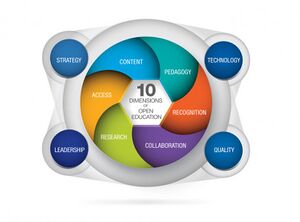
OE Policy framework
Atenas, J., Haverman, L., Cronin, C., Rodés, V., Lesko, I., Stacey, P., Feliu-Torruella, M., Buck, E., Amiel, T., Orlic, D., Stefanelli, C., & Villar, D. (2022). Defining and developing ‘enabling’ Open Education Policies in higher education.
"Key elements of OE policies are identified: capacity building; learning accreditation/credit transfer; access and inclusivity; diverse access to knowledge; platform governance; and fostering a culture of openness. OE policies, whether standalone or incorporated into a wider openness policy, should be designed to cohere with other policies addressing open content and practices. This brief seeks to promote the involvement of a wide range of stakeholders in institutional policymaking process via a co-creation approach".
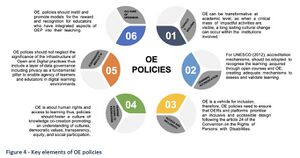 |
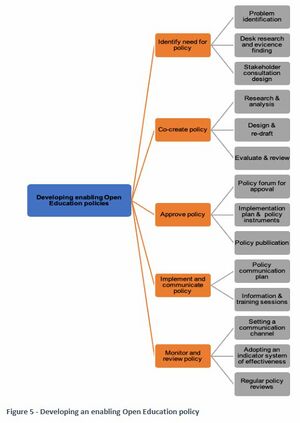 |
|---|
Quality in open, online and flexible learning
Ossiannilsson, E. (2020). Quality Models for Open, Flexible, and Online Learning. Journal of Computer Science Research, 2(4).
"This article is based on research conducted for the European Commission Education & Training 2020 working group on digital and online learning (ET2020 WG-DOL) specifically regarding policy challenges, such as the following: 1) Targeted policy guidance on innovative and open learning environments under outcome; 2) Proposal for a quality assurance model for open and innovative learning environments, its impact on specific assessment frameworks and its implication for EU recognition and transparency instruments. The article aims to define quality in open, flexible, and online learning, particularly in open education, open educational resources (OER), and massive open online courses (MOOC). [...] Finally, the article discusses the rationale and need for a model of quality in open, flexible, and online learning based on three major criteria for quality: excellence, impact, and implementation from the learner’s perspective."
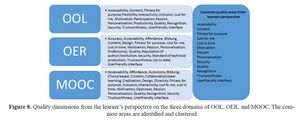
Educators' OE competencies
Padilla-Zea, N., Burgos, D., García-Holgado, A., García-Peñalvo, F. J., Harquevaux, M. P., de-la-Higuera, C., Brunton, J., & Tlili, A. (2022). Catch the Open! A Gamified Interactive Immersion Into Open Educational Practices for Higher Education Educators. Frontiers in Psychology, 13.
"Catch the Open! targets HE educators who wish to learn, or who wish to deepen their existing knowledge, about OE and Open Educational Practices (OEP). Within the gamified learning experience, the user becomes an educator, Alex, the game character, who receives a task from the Rector: to investigate how to best include OE and OEP in teaching and learning practice bwithin the institution. [...] Catch the Open! targets HE educators who wish to learn, or who wish to deepen their existing knowledge, about OE and Open Educational Practices (OEP). Within the gamified learning experience, the user becomes an educator, Alex, the game character, who receives a task from the Rector: to investigate how to best include OE and OEP in teaching and learning practice within the institution".
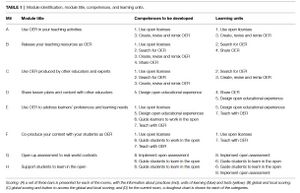
Value-First Framework in Open Pedagogy
Werth, E., & Williams, K. (2022). The why of open pedagogy: a value-first conceptualization for enhancing instructor praxis. Smart Learning Environments, 9(1), 10.
"This article seeks to explore the gap between theory and practice by examining how the use of terms within the open education space may create barriers for instructors new to the concept. The authors of this article argue that the most effective approach to creating momentum toward practices associated with Open Pedagogy is to begin with an alignment of an instructor’s values with the attributes of an open educator.The result is a visual aid useful for an instructor’s self-assessment or in collaboration with curriculum designers to identify a logical start point for an instructor as they begin their movement from a more traditional to an open approach."
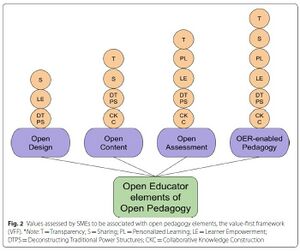
Open Educational Practices for Social justice
Bali, M., Cronin, C., & Jhangiani, R. S. (2020). Framing Open Educational Practices from a Social Justice Perspective. Journal of Interactive Media in Education, 1.
"This article attempts to build on existing OEP research and practice in two ways. First, we provide a typology of OEP, giving examples of practices across a continuum of openness and along three axes: from content-centric to process-centric, teacher-centric to learner-centric, and practices that are primarily for pedagogical purposes to primarily for social justice (Bali 2017). Second, we employ Hodgkinson-Williams and Trotter’s (2018) conceptual framework, which builds on Fraser’s model of social justice, to critically analyse the ways in which the use/impact of OEP might be considered socially just, with a particular focus on expansive, process-centric OEP. We analyze for whom and in which contexts OEP can (i) support social justice along economic, cultural and political dimensions, and (ii) do so in transformative, ameliorative, neutral or even negative ways. We use the typology and framework to analyse specific process-centric forms of OEP including collaborative annotation, Wikipedia editing, open networked courses, Virtually Connecting, public scholarship, and learner-created OER."
Open Thinking Scale
Jung, I., & Lee, J. (2022). Open thinking as a learning outcome of open education: scale development and validation. Distance Education, 43(1), 119-138.
"Aim: develop and validate a multidimensional open thinking scale (OTS) in order to measure adult learners’ open thinking as a key learning outcome of open educational practices (OEP) through a three-phase process of item generation, theoretical analysis, and psychometric analysis. Exploratory and confirmatory factor analyses of data from 610 students in 24 countries revealed a clear structure consisting of six constructs of open thinking: openness to multiple perspectives, openness to new learning, openness to collaboration, openness to sharing, openness to change, and openness to diversity and inclusion".
- Openness to new perspectives: Reverse of omniscient authority; Reverse of certain knowledge; Reality as dynamic and changing; Reality as multifaceted; Open to revise beliefs if discovered wrong
- Openness to different ways of learning: Openness to opportunities; Initiative and independence; Positive future; Less value on academic degree; Diverse sources of learning; Global mind
- Openness to collaboration: Collaborative learning style;
- Openness to sharing: Attitude toward sharing resources; Openness to change; Adapting to new learning situations; Positive perception of change; Change seeking; Technology acceptance
- Openness to change: Adapting to new learning situations; Positive perception of change; Change seeking; Technology acceptance
- Openness to diversity and inclusion: Value or appreciation; Learning or knowledge; Intercultural interaction; Social justice; Discipline practice
Reflecting about potential underlying epistemologies of OE
Questioning the dominant model
How academic knowledge was gained and research conducted in the recent past (approximately two centuries) is questioned today (e.g. Framework for Open and Reproducible Research Training, FORTT). Several research domains - e.g. social studies of sciences, history of sciences, decolonising studies – criticise it for conveying “institutional positivism” (Piron, 2019). The gaining interest of epistemic justice as a research and social topic is an example of this movement (e.g. Eve & Gray, 2020; Kidd, Medina & Pohlhaus, 2017) against prevalent scientific knowledge production models.
UNESCO (2021)’s recent Open Science definition is also very insightful in this respect. It stresses the importance of acknowledging the diversity of knowledge: "open science is defined as an inclusive construct that combines various movements and practices aiming to make multilingual scientific knowledge openly available, accessible and reusable for everyone, to increase scientific collaborations and sharing of information for the benefits of science and society, and to open the processes of scientific knowledge creation, evaluation and communication to societal actors beyond the traditional scientific community. It comprises all scientific disciplines and aspects of scholarly practices, including basic and applied sciences, natural and social sciences and the humanities, and it builds on the following key pillars: open scientific knowledge, open science infrastructures, science communication, open engagement of societal actors and open dialogue with other knowledge systems".
Epistemologies and conceptual frameworks
Research method textbook commonly cite positivism, constructivism, the transformative view and pragmatism as the main epistemologies (e.g. Creswell & Cresswell, 2018).
The GO-GN research method handbook and their Conceptual Frameworks Guide or the Guide décolonisé de formation à la recherche en sciences sociales et humaines reach out to many more epistemologies and framework (e.g. Critical / Transformational methods; Value Creation Framework; Activity theory; Sociological Theories of Power).
To their long list, we would like to add: actor-network theory / sociomateriality (Latour, 2006), epistemology of the link (Piron, 2019), Ubu-ntu (Ramose, 2015), sociology of absences and emergences (Santos, 2016) and buen vivir (Arauz, 2022).
For a very brief overview of these epistemologies, let us mention that Actor-network theory (ANT) is part of sociomateriality. Sociomaterial approaches share three common components. First, they study the system as one entire entity, composed of entangled human and non-human action and knowledge. Second, they focus on interactions and mediations - not on individuals or artefacts. Third, they consider knowledge and learning as embodied and embedded in actions and interactions (Fenwick, Edwards & Sawchuk, 2012). No hierarchy exist and certainly no privileged position for the human over the non-human. Binary categories such as usually discussed - agency-structure; subject-object; theory-practice - are considered not appropriate. The purpose of sociomaterial approaches is related to boundary-making processes and featuring out those which create knowledge. Key technical terms of this approach are assembling / reassembling, dynamics of entities, and, connections, with the aim of tracing how knowledge is produced. ANT in education research addresses flows, connections and interactions between human and material objects enacted for the purpose of learning with the aim of understanding how knowledge is produced (Fenwick, et al., 2012).
Epistemology of the link is inspired from Edgard Morin’s concept of “reliance” (from the French “lier”, linking). It is characterised by thinking in interaction with the human mankind to prevent isolation and considers thinking as an endeavour to make sense in interaction with others. It is on the move, interpretative, connecting, linking and is totally different from dogmas learnt by heart and repeated. It calls upon social and epistemic justice for a humanising science that makes sense in our world and connects ideas and beings (Piron, 2019). It is a call to cease the injunction of separation between the researcher and the object of research that is prevalent in Western epistemic traditions. It is an epistemology in the making that relies on Santos (2016 cited by Piron) call for an ecology of knowledge, an ecosystem in which diverse types of knowledge, without hierarchy, are in dialogue (Piron, 2017, p. 46).
Epistemology of Ubuntu, translated as humanness, “suggests both a condition of being and the state of becoming, of openness or ceaseless unfolding”(Ramose, 2015, p. 69). Ubuntu considers “the universe as a complex wholeness involving the multi-layered and incessant interaction of all entities” (Ramose, 2015, p. 69) – human beings, physical or objective nature. The three driving insights of Ubuntu are: 1) constant motion of “wholes” from generation to death to regeneration; 2) human dignity; 3) mutual care and sharing between human beings and physical nature (Ramose, 2015). See also the course on Ubuntu within the Become an Open Educator Influencer initiative.
The sociology of absences and emergences is an approach suggested by Boaventura de Sousa Santos. “Sociology of absences focuses on social experiments to explore what exists of the South that is independent from the North/South constructed dichotomy. It is about researching, with non-modern mindsets and epistemologies what exists beyond the abyssal line (Santos, 2016, p. 251 and following). Sociology of emergences aims to symbolically increase the importance of knowledge, practices and actors to identify future trends, on which it is possible to increase the probability of hope against the probability of frustration. It acts on possibilities (potentials) and capacities (legitimate authority, power) and focuses on care, without being deterministic” (Class, 2022).
The buen vivir indigenous approach of Latin America is about enabling the permanency of cultural and environmental diversity; it is harmony, equality, equity and solidarity. It is not the quest for opulence or infinite economic growth. It is not extractivist (Arauz 2022).
From epistemologies to theories
From these epistemologies, theories engaging in totally new worldviews and opening new horizons for learning are (re)emerging. The main one is the theory of abundance. It moves away from scarcity and its keyword is “enough”. Enough open and quality networks, resources, institutions, etc. to learn from and be able to grow as a responsible citizen in a knowledge economy in all the places on earth (Caron, 2020; Hoeschele, 2010).
In terms of learning theories, those which are most suited for OE are the following ones (non exhaustive list):
- connectivism (Siemens, 2005; Downes, 2007)
- rhizomatic learning (Cormier, 2010)
- social theories of learning like communities of practice (Lave & Wenger, 1991; Wenger, 2018)
- multiple approaches to understanding (Gardner, 2018).
- experiential learning (Usher, 2018)
- theories that need to be created...
Major technological advancements happened in the 1960s-70s-80s-90s, in part thanks to the free software movement. My conjecture is also that technology, such as the creation of the Internet in the 1960s and the world wide web in the 1990s (cf. https://home.cern/science/computing/birth-web) , permitted to revive essential features of scientific communities, i.e. transparency, freedom, sharing. Indeed, it is hardly known that scientific articles were public goods until the 1900s (Dulong de Rosnay & Langlais, 2017) and that scientific knowledge circulated freely beforehand. Thus, values of the free software movement, making free software a public good, converged with pre-existing values in scientific communities, resulting in open circulation of knowledge.
It is not clear whether Internet is a public good today but originally it was created in that spirit. It is also acknowledged that the web opened a myriad of possibilities, it “became central to public access to the internet and also enabled the creation of a global knowledge network” (Harasim, 2017, p. 26).
Finally, let us keep in mind that it was in the late 90s that the Bologna reform was adopted in European higher education to build the knowledge society and the knowledge economy (Huisman, Adelman, Hsieh, Shams & Wilkins, 2012). It was also in those years that the Creative Commons project was being prepared to offer sustainable legal solutions to openly shared content. Finally, it was in those years that the free operating system Ubuntu was created and disseminated worldwide (cf. https://ubuntu.com/community/mission).
Open paradigm in higher education
Today, in higher education, almost any scholar has heard of Open Science or Open Educational Resources.
Contemporary Open Education (OE) is in the making. Several milestones have been set, as for instance, the core underlying principles of education considered as a commons and including design for access, equity, agency, ownership, participation, distribution, innovation and sustainability (Blessinger & Bliss, 2016; Stacey & Hinchliff Pearson, 2017). Its concrete implementation in higher education is still to be invented but a guiding framework has been suggested (Inamorato dos Santos, Punie & Castaño Muñoz, 2016) and different research projects have experienced some parts of OE or some parts of the framework (e.g. Open book project; OpenMed; Open Game; Encore+).
Concerning core teaching and learning activities, OE is discussed in terms of Open Educational Resources (OER) – how to produce, adopt and adapt them (Stracke, Downes, Conole, Burgos & Nascimbeni, 2019; Weller, Jordan, DeVries & Rolfe, 2018). In terms of OE practices, it is teaching openness (Nascimbeni, Burgos, Campbell & Tabacco, 2018) and conceptual perspectives (Cronin & Maclaren, 2018) which are discussed. Issues of open admission, open recognition, open assessment and open credentials are discussed at the theoretical level (Wiley, 2017) and at the cultural change level (Chiappe, Pinto & Arias, 2016). Return of concrete experiences are starting to be shared (García-Holgado, et al., 2020). Concerning quality, a first OE quality framework, in reference to ISO/IEC 40180, has been suggested (Stracke, 2019). At the strategic and leadership levels, major identified OE enablers are i) a clear policy priority assigned to open education; ii) an awareness-raising on open education, targeting leaders and educators; and iii) capacity-building in open education for educators and other stakeholders (Inamorato dos Santos, et al., 2017). Concerning technology, projects like QualiChain (cf. https://qualichain-project.eu/ ) work on smart open badges solutions and a reflexion on technological compliant solutions is on-going (Coëtlogon, 2019). In addition, Daniel Burgos and colleagues have issued several valuable books on OE with many insights (e.g. Burgos, 2020; Burgos & Olivier, 2021; Burgos, Tlili & Tabacco, 2021).
Thinking about the lifecycle of an OE course
OE can be discussed at different levels of granularity and has the immense advantages of possibly happening outside of academia and being acredited with micro-credentials (Clements et al. 2020; Ehrenreich, 2020; West et al. 2020). OE can also happen in academia and the diagram below shows one such possibility. The big changes reside in the fact that: i) the teacher does not design the course on his own; ii) evaluation takes the form of renewable assignements. Several scholars research Open Educational Practices (Cronin & Maclaren, 2018) that also entail personal learning networks (Neelen & Kirschner, 2018).
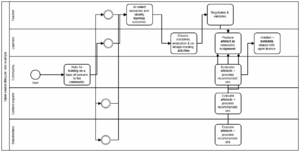
External links and resources
Open Education on Wikipedia
Introduction to Open Education https://www.edx.org/course/introduction-to-open-education 2018 course by George Siemens and David Wiley
Open Education, https://www.open.edu/openlearn/education-development/open-education/ 2018 course by the Open University UK
Open Education Handbook, https://en.wikibooks.org/wiki/Open_Education_Handbook 2014
What do we mean by ‘open’ in education? https://www.tonybates.ca/2015/02/16/what-do-we-mean-by-open-in-education/ 2014, Tony Bates
Using Open Content, https://www.jisc.ac.uk/guides/technology-and-tools-for-online-learning/using-open-content 2016, JISC
European Distance and e-Learning Network, Open Education week, https://www.eden-online.org/eden_conference/oew-summary/ 2017-2021
Open Education Global, OE week, https://oeweek.oeglobal.org/ 2022
Master in Leadership in Open Education > programme and course contents https://www.ung.si/en/schools/school-of-engineering-and-management/programmes/2NVOI/
Open Education for a Better World, https://oe4bw.org/
Becoming an open educator https://www.open.edu/openlearncreate/course/view.php?id=2274 2016, Open University
Aspects of the Open: The evolution of the meaning of open education https://www.open.ac.uk/research/news/aspects-open-evolution-meaning-open-education 2019, Martin Weller
OER Hub http://oerhub.net/ Open University
GO GN (Global OER graduate network) https://go-gn.net/ Open University
BOEI course - Become an Open Education Influencer http://openedinfluencers.mandela.ac.za/courses/ Mandela University, South Africa
Open Education Policy Hub, https://www.oepolicyhub.org/ , project of OER worldmap, https://oerworldmap.org/resource/ , Open University involved.
Chaire UNESCO REL IA (OER and AI), in French, https://chaireunescorel.ls2n.fr/, Université de Nantes
Open Educational Practices whitepaper (work in progress), multilingual, https://houseofcommons.ch/wiki/index.php?title=Open_Education
References
Arauz, A. (2022). Buen Conocer: Socially oriented policies at the Ministry of Knowledge of Ecuador Open Education Global, Nantes, France. https://mediaserver.univ-nantes.fr/videos/oeg-keynote-2-andres-arauz-450-day-2-session-1acrop/
Baker, F. W. (2017). An Alternative Approach: Openness in Education Over the Last 100 Years. TechTrends, 61(2), 130-140. https://doi.org/10.1007/s11528-016-0095-7
Bates, A. W. (2015). Teaching in a Digital Age. Guidelines for designing teaching and learning for a digital age. Online open textbook.
Blessinger, P. & Bliss, T. J. (2016). Introduction to Open Education: Towards a Human Rights Theory. In P. Blessinger & T. J. Bliss (Eds.), Open Education. International Perspectives in Higher Education (pp. 11-30). Cambridge, UK: Open Book Publishers.
Brière, L., Lieutenant-Gosselin, M. & Piron, F. (2019). Et si la recherche scientifique ne pouvait pas être neutre? . Éditions science et bien commun.
Burgos, D. (Ed.). (2020). Radical Solutions and Open Science : An Open Approach to Boost Higher Education. Springer Singapore. https://doi.org/10.1007/978-981-15-4276-3
Burgos, D., & Olivier, J. (2021). Radical Solutions for Education in Africa: Open Education and Self-directed Learning in the Continent. Springer Singapore. https://doi.org/10.1007/978-981-16-4099-5
Burgos, D., Tlili, A., & Tabacco, A. (Eds.). (2021). Radical Solutions for Education in a Crisis Context: COVID-19 as an Opportunity for Global Learning. Springer https://doi.org/10.1007/978-981-15-7869-4
Callon, M. (2006). Sociologie de l'acteur réseau In M. Akrich, M. Callon & B. Latour (Eds.), Sociologie de la traduction. Textes fondateurs (pp. 267-276). Paris: Mines Paris. Les Presses.
Caron, B. R. (2020). Open Scientist Handbook. https://openscientist.pubpub.org/pub/play/release/2
Chiappe, A., Pinto, R. & Arias, V. (2016). Open Assessment of Learning: A Meta-Synthesis. International Review of Research in Open and Distributed Learning, 17(6), 44-61.
Class, B. (2022). Open Education: Towards Epistemic Sustainability. In International Conference on Computer Supported Education. https://doi.org/10.5281/zenodo.6341503
Clements, K., West, R. E., & Hunsaker, E. (2020). Getting Started With Open Badges and Open Microcredentials. The International Review of Research in Open and Distributed Learning, 21(1), 154-172. https://doi.org/10.19173/irrodl.v21i1.4529
Cormier, D. (2010). Community as Curriculum and Open Learning. http://davecormier.com/edblog/2010/06/17/community-as-curriculum-and-open-learning/;
Coëtlogon, P. (2019). Vers une blockchain dédiée à l’éducation, capable de certifier les diplômes comme les droits de propriété intellectuelle ? https://www.actualitesdudroit.fr/browse/tech-droit/blockchain/20993/vers-une-blockchain-dediee-a-l-education-capable-de-certifier-les-diplomes-comme-les-droits-de-propriete-intellectuelle
Coppe, T., März, V., Decuypere, M., Springuel, F. & Colognesi, S. (2018). Ouvrir la boîte noire du travail de préparation de l’enseignant : essai de modélisation et d’illustration autour du choix et de l’évolution d’un document support de cours. Revue française de pédagogie, 204(3), 17-31.
Creswell, J. & Cresswell, D. (2018). Research design: Qualitative, quantitative, and mixed methods approaches. (5the éd.). Los Angeles: Sage.
Cronin, C. M. G. & Maclaren, I. (2018). Conceptualising OEP: A review of theoretical and empirical literature in Open Educational Practices. Open Praxis, 10, 127-143, https://openpraxis.org/articles/10.5944/openpraxis.10.2.825/ .
Dulong de Rosnay, M. & Langlais, P.-C. (2017). Public artworks and the freedom of panorama controversy: a case of Wikimedia influence. Internet Policy Review, 6(1).
Eduvista. (2010-2014). Innovation Maturity Model. http://files.eun.org/fcl/eduvista/eduvista-tool-2p1.pdf
Ehrenreich, J., Mazar, I., Rampelt, F., Schunemann, I., & Sood, I. (2020). Recognition and Verification of Credentials in Open Education – OEPASS. https://oepass.eu/outputs/io3/
Eve, M. P. & Gray, J. (dir.). (2020). Reassembling Scholarly Communications. Histories, Infrastructures, and Global Politics of Open Access Cambridge: MIT Press.
Fenwick, T., Edwards, R. & Sawchuk, P. (2012). Why sociomateriality in education? An introduction. In T. Fenwick, R. Edwards & P. Sawchuk (Eds.), Emerging Approaches to Educational Research (pp. 1-17). London: Routledge.
García-Holgado, A., García-Peñalvo, F. J., Vázquez-Ingelmo, A., Nascimbeni, F., Padilla-Zea, N., Burgos, D., . . . Brunton, J. (2020). Handbook of successful open teaching practices. OpenGame Consortium.
Gardner, H. (2018). Multiple approaches to understanding. In K. Illeris (Eds.), Contemporary theories of learning. Learning theorists... In their own words (2nde éd., pp. 129-138). London and New York: Routledge.
Harasim, L. (2017). Learning Theory and Online Technologies. (2e éd.). Routledge.
Hoeschele, W. (2010). The economics of abundance : a political economy of freedom, equity, and sustainability. Farnham: Routledge, Gower.
Huisman, J., Adelman, C., Hsieh, C., Shams, F. & Wilkins, S. (2012). Europe's Bologna process and its impact on global higher education In D. K. Deardorff, H. D. Wit & J. D. Heyl (Eds.), The SAGE Handbook of International Higher Education (pp. 81-100). Thousand Oaks: SAGE Publications, Inc.
Inamorato dos Santos, A., Nascimbeni, F., Bacsich, P., Atenas, J., Aceto, S., Burgos, D. & Punie, Y. (2017). Policy Approaches to Open Education Europen Commission.
Inamorato dos Santos, A., Punie, Y. & Castaño Muñoz, J. (2016). Opening up education. A support framework for higher education institutions. Seville: JRC Science Hub.
Kidd, I., Medina, J. & Pohlhaus, G. (2017). The Routledge Handbook of Epistemic Injustice. New York: Routledge.
Laot, F., & Rogers, R. (2015). Question éducative et recherche dans l'après Seconde Guerre mondiale. In F. Laot & R. Rogers (Eds.), Les Sciences de l'éducation. Emergence d'un champ de recherche dans l'après-guerre. Presses universitaires de Rennes.
Latour, B. (2006). Nous n'avons jamais été modernes: Essai d'anthropologie symétrique. Paris: La Découverte.
Lave, J. & Wenger, E. (1991). Situated Learning. Legitimate peripheral participation. Cambridge: University of Cambridge Press. Mertens, D. M. (2017). Transformative research: personal and societal. International Journal for Transformative Research, 4(1), 18-24.
Nabudere, D. (2005). Ubuntu Philosophy.Memory and Reconciliation. https://repositories.lib.utexas.edu/bitstream/handle/2152/4521/3621.pdf
Nascimbeni, F., Burgos, D., Campbell, L. M. & Tabacco, A. (2018). Institutional mapping of open educational practices beyond use of Open Educational Resources. Distance Education, 39(4), 511-527.
Neelen, M., & Kirschner, P. (2018). How to effectively build and leverage a personal learning network (PLN). https://3starlearningexperiences.wordpress.com/2018/09/04/how-to-effectively-build-and-leverage-a-personal-learning-network-pln/
Peter, S., & Deimann, M. (2013). On the role of openness in education: A historical reconstruction. Open Praxis, 5(1), 7-14. https://doi.org/10.5944/openpraxis.5.1.23
Piron, F. (2017). Méditation haïtienne : répondre à la violence séparatrice de l’épistémologie positiviste par l’épistémologie du lien. Sociologie et sociétés, 49(1), 33-60.
Piron, F. (2019). L’amoralité du positivisme institutionnel. L'épistémologie du lien comme résistance In L. Brière, M. Lieutenant-Gosselin & F. Piron (Eds.), Et si la recherche scientifique ne pouvait pas être neutre? : Éditions science et bien commun.
Ramose, M. (1999). African Philosophy Through Ubuntu.
Ramose, M. (2015). Ecology through Ubuntu. In R. Meinhold (Eds.), Environmental Values. Emerging from Cultures and Religions of the ASEAN Region (pp. 69-76). Bangkok: Konrad Adenauer Stiftung.
Rohstock, A. (2015). Pour une recherche scientifique en éducation? Une idée internationale et son appropriation locale en Allemagne de l'Ouest au mooment de la guerre froide. In F. Laot & R. Rogers (Eds.), Les Sciences de l'éducation. Emergence d'un champ de recherche dans l'après-guerre. Presses universitaires de Rennes.
Santos, B. d. S. (2016). Épistémologies du Sud : mouvements citoyens et polémique sur la science. Paris: Desclée de Brouwer.
Sinkinson, C. & McLure, M. (2020). Care in the Open. https://caring.openped.buffscreate.net/ (Framework not publication)
Stacey, P. (2018). Starting Anew in the Landscape of Open. https://edtechfrontier.com/2018/02/08/starting-anew-in-the-landscape-of-open/
Stacey, P. & Hinchliff Pearson, S. (2017). Made With Creative Commons. Denmark: Ctrl+Alt+Delete Books.
Stracke, C. (2019). Quality Frameworks and Learning Design for Open Education. The International Review of Research in Open and Distributed Learning, 20(2).
Stracke, C., Downes, S., Conole, G., Burgos, D. & Nascimbeni, F. (2019). Are MOOCs open educational resources? A literature review on history, definitions and typologies of OER and MOOCs. Open Praxis, 11(4).
Trouche, L., Gueudet, G. & Pepin, B. (2019). The 'Resource' Approach to Mathematics Education. Cham: Springer International Publishing.
UNESCO. (2019). Recommendation on Open Educational Resources. http://portal.unesco.org/en/ev.php-URL_ID=49556&URL_DO=DO_TOPIC&URL_SECTION=201.html
UNESCO. (2020). Upcoming Decade of Indigenous Languages (2022 – 2032) to focus on Indigenous language users’ human rights. https://en.unesco.org/news/upcoming-decade-indigenous-languages-2022-2032-focus-indigenous-language-users-human-rights
UNESCO. (2021). Recommendation on Open Science. https://unesdoc.unesco.org/ark:/48223/pf0000379949.locale=en
Usher, R. (2018). Experiential learning. In K. Illeris (Eds.), Contemporary theories of learning (2e éd., pp. 189-203). Oxon and New York: Routledge.
Weller, M. (2014). The Battle for Open: How Openness Won and Why it Doesn’t Feel Like Victory. Ubiquity Press. https://doi.org/10.5334/bam
Weller, M., Jordan, K., DeVries, I. & Rolfe, V. (2018). Mapping the open education landscape: citation network analysis of historical open and distance education research. Open Praxis, 10(2), 109-126.
West, R. E., Newby, T., Cheng, Z., Erickson, A., & Clements, K. (2020). Acknowledging All Learning: Alternative, Micro, and Open Credentials. In M. J. Bishop, E. Boling, J. Elen, & V. Svihla (Eds.), Handbook of Research in Educational Communications and Technology: Learning Design (pp. 593-613). Springer International Publishing. https://doi.org/10.1007/978-3-030-36119-8_27
Wenger, E. (2018). A social theory of learning. In K. Illeris (Eds.), Contemporary theories of learning. Learning theorists... In their own words (2nde éd., pp. 219-228). London and New York: Routledge.
Wiley, D. (2017). Iterating Toward Openness: Lessons Learned on a Personal Journey. In R. S. Jhangiani & R. Biswas-Diener (Eds.), Open: The Philosophy and Practices that are Revolutionizing Education and Science (pp. 195-207). London: Ubiquity Press.
Year of Open (2017). The Year of Open is a global focus on open processes, systems, and tools, created through collaborative approaches, that enhance our education, businesses, governments, and organizations https://www.yearofopen.org/